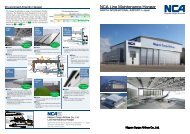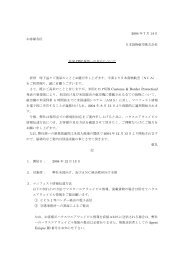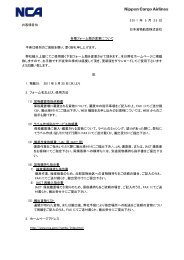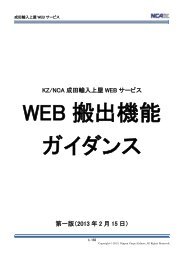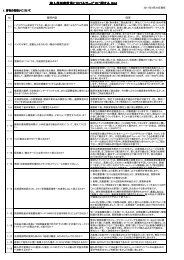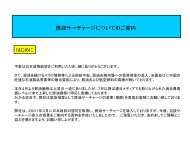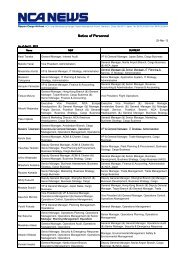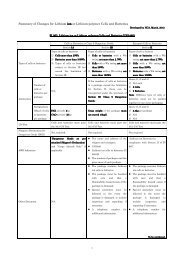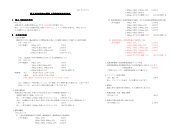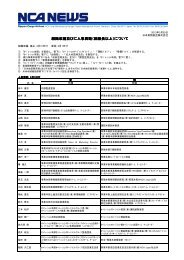Handling of Lithium Ion batteries following Amendment of IATA ...
Handling of Lithium Ion batteries following Amendment of IATA ...
Handling of Lithium Ion batteries following Amendment of IATA ...
Create successful ePaper yourself
Turn your PDF publications into a flip-book with our unique Google optimized e-Paper software.
Dear Customers<br />
Mar. 02, 2009<br />
N I P P O N C A R G O A I R L I N E S C O . , L T D .<br />
J a p a n A i r l i n e s I n t e r n a t i o n a l C o . , L t d .<br />
A L L N I P P O N A I R W A Y S C O . , L T D .<br />
<strong>Handling</strong> <strong>of</strong> <strong>Lithium</strong> Metal and <strong>Lithium</strong> <strong>Ion</strong> <strong>batteries</strong> <strong>following</strong> <strong>Amendment</strong> <strong>of</strong> <strong>IATA</strong> Regulations<br />
(<strong>Amendment</strong>)<br />
This letter has been revised in compliance with the addendum to Dangerous Goods Regulations 50 th edition,<br />
posted on 23 December, 2008 and the guidance document posted on 06 February, 2009 by the <strong>IATA</strong>. The<br />
amended items in this letter are highlighted in blue to help identify the amendment.<br />
Thank you for your understanding and cooperation for flight safety.<br />
Regulations on lithium <strong>batteries</strong> in <strong>IATA</strong> Dangerous Goods Regulations 50 th Edition (hereinafter <strong>IATA</strong> DGR)<br />
to take force on January 1, 2009 will be amended. Basically, handling is performed in conformance with<br />
<strong>IATA</strong> DGR, but we expect cases where handling may not be uniform among carriers due to difference in<br />
interpretation. To ensure flight safety and smooth handling, we have unified handling as described below.<br />
We would appreciate your understanding and cooperation.<br />
Transport <strong>of</strong> lithium <strong>batteries</strong> handled as Part 1 <strong>of</strong> the Packing Instructions, NOT RESTRICTED<br />
Please check requirement in Part 1 <strong>of</strong> the applicable Packing Instruction PI 965, 966, 967, 968, 969<br />
and 970.<br />
Information on Air Waybill<br />
Please fill in the AWB as below. If it is difficult to complete due to space, etc. you may use a separate<br />
sheet. When doing so, write all items from (a) to (d). In this case, write (a) on the AWB repeatedly.<br />
In case <strong>of</strong> 4, 7 on Attachment 1, please write (a) on the AWB .(This provision is not shown in DGR.<br />
However , we would like you to declare that the packages are properly prepared in accordance with<br />
Part 1 for smooth handling.)<br />
(a)Indicate that the package contains <strong>Lithium</strong> ion (or metal or ion and metal) Batteries as below .<br />
<strong>Lithium</strong> ion <strong>batteries</strong> or cells, NOT RESTRICTED as per PI 9xx Part1; or<br />
<strong>Lithium</strong> metal <strong>batteries</strong> or cells, NOT RESTRICTED as per PI 9xx Part1; or<br />
<strong>Lithium</strong> ion and metal <strong>batteries</strong> or cells, NOT RESTRICTED as per PI 9xx Part1.<br />
(b) Considering the package must be handled with care due to the risk <strong>of</strong> fire if the package is<br />
damaged, indicate as in the <strong>following</strong> statement.<br />
e.g.“The package must be handled with care and a flammability hazard exists, if the package is<br />
damaged.”<br />
(c) Write handling procedures, etc. in case the package is damaged, according to applicable<br />
Packing Instruction<br />
e.g.“Do not damage or mishandle this package. If package is damaged, <strong>batteries</strong> must be<br />
protected so as to prevent short circuit. ”<br />
(d) Write a telephone number for additional information.<br />
e.g. Contact TEL Number 81-476-33-XXXX Japan<br />
1-800-424-XXXX 1-703-527-XXXX (US) etc.<br />
Drop test <strong>of</strong> package<br />
If there is a drop test requirement in the Packing Instruction, use a packaging that has passed the<br />
drop test (1.2m). Especially, in case that battery packed with equipment in the same packaging, it is<br />
mandatory to conduct a drop test including the equipment. Please retain the results <strong>of</strong> the test. If there<br />
is a trouble or if an incident/accident occurs, you may be asked to submit the test results by the carrier<br />
or the competent authority.<br />
Affixing lithium battery handling label<br />
Each package must be labeled with a lithium battery handling label indicating (a) <strong>Lithium</strong> ion battery<br />
(b) <strong>Lithium</strong> metal battery (c) <strong>Lithium</strong> ion and metal <strong>batteries</strong>.<br />
When affixing <strong>Lithium</strong> Battery Labels with <strong>IATA</strong> 7.4.8 FIGURE 7.4.I specifications, they must not
e folded or affixed in such a manner that parts <strong>of</strong> the same label appear on different faces <strong>of</strong> the<br />
package. Please note that affixing <strong>of</strong> labels is exempted, when transporting <strong>batteries</strong> contained in<br />
equipment, in case that each package containing not more than four cells or not more than two<br />
<strong>batteries</strong> in equipment. ( Attachment 1, item 4, 7)<br />
Indication <strong>of</strong> Watt-hour<br />
As for lithium ion <strong>batteries</strong> 100Wh and below, it is necessary to indicate Watt-hour rating on the<br />
battery case exterior. However, for lithium ion <strong>batteries</strong> manufactured before December 31, 2008,<br />
indication is exempted until December 31, 2010.<br />
Duplication <strong>of</strong> old marking and new labeling<br />
For duplication <strong>of</strong> old marking and new labeling during transition period which Japanese customers<br />
concern, there are no problems <strong>of</strong> overlapping markings required under current regulations until<br />
December 31, 2008 (including labels) and new labels. However, from/after January 1, 2009, please<br />
affix new labels only as soon as possible. (The overlapping period is not specified.) When old and<br />
new markings and labels overlap, please take care so that there are no discrepancies. (e.g. one<br />
marking indicates <strong>Lithium</strong> ion Battery, the other Primary <strong>Lithium</strong> Battery)<br />
Package and Overpack<br />
Package means the package, ready for carriage, contains “<strong>Lithium</strong> ion and/or metal Battery(ies)” or<br />
“<strong>Lithium</strong> ion and/or metal Battery(ies) packed with equipment(s)” or “<strong>Lithium</strong> ion and/or metal<br />
Battery(ies) contained in equipment(s)”. The package must be suitable for labeling and handling for<br />
Air transport, and must meet all requirements in Part 1 <strong>of</strong> the applicable Packing Instructions<br />
(including drop test if required).<br />
If one or more outer packaging is packed in one outer enclosure or containment, it will be considered<br />
as “Overpack” in accordance with the relevant provisions in the <strong>IATA</strong> DGR, even if the <strong>batteries</strong> in<br />
question are transported under the scope <strong>of</strong> Part 1 in an “Exempt ”scenario.<br />
In case <strong>of</strong> overpack, the number <strong>of</strong> overpacks is number <strong>of</strong> pieces on the AWB.<br />
Each individual package placed in an overpack must be labelled with the <strong>Lithium</strong> Battery Label.<br />
An overpack must be marked with the word “Overpack” and labelled with the <strong>Lithium</strong> Battery Label,<br />
unless the label(s) on the package(s) inside the overpack are visible.(PI966 and PI 969 are also<br />
subject to this provision in accordance with the Guidance Documents by the <strong>IATA</strong>)<br />
Misc.<br />
Please observe State & Operator Variations. Especially, as regards USG-02, UN3090 - (primary<br />
/non-rechargeable) lithium metal <strong>batteries</strong> and cells are forbidden for transportation aboard<br />
passenger-carrying aircraft and UN3091 – (primary /non-rechargeable) lithium metal <strong>batteries</strong> and<br />
cells packed with or contained in equipment that do not conform to the provision concerned <strong>of</strong> 49CFR<br />
are forbidden for transportation aboard passenger-carrying aircraft.<br />
Transport <strong>of</strong> lithium <strong>batteries</strong> handled as Part 2 <strong>of</strong> the Packing Instructions<br />
Please check requirements in applicable Packing Instruction PI 965, 966, 967, 968, 969 and 970,<br />
Part 2.<br />
For more details, please contact each operator.<br />
Attachment 1 Guide for <strong>Lithium</strong> Metal and <strong>Lithium</strong> <strong>Ion</strong> Batteries <strong>Handling</strong>(NOT RESTRICTED,<br />
Labeling, Marking and Completion <strong>of</strong> AWB)<br />
end


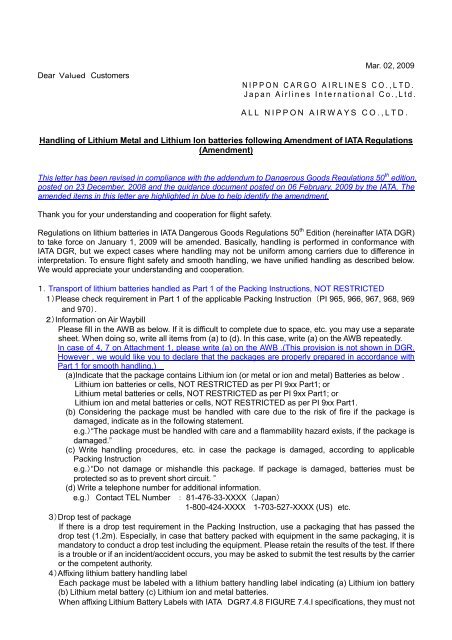

![[Attachment] Fuel Surcharge Table](https://img.yumpu.com/13953032/1/184x260/attachment-fuel-surcharge-table.jpg?quality=85)
